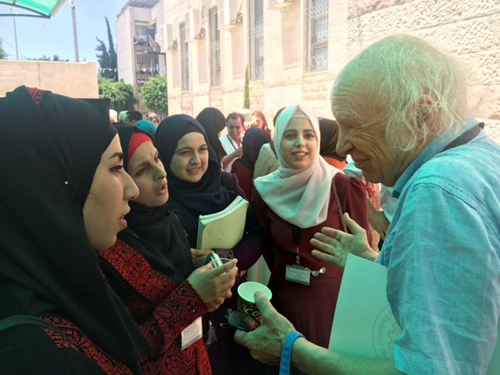Meetings: Building Opportunities for Palestinian Science
For about a decade, Palestinian researchers have been organizing the Palestinian Conference on Modern Trends in Mathematics and Physics—one of the largest scientific events in the West Bank. The conference rotates every two years among Palestinian universities and offers local students and researchers a chance to learn about scientific developments, establish collaborations within and outside of the Palestinian Territories, and network with foreign researchers. I was invited to speak about scientific communication at this year’s conference, which was held in early August at the Palestinian Technical University–Kadoorie (PTUK) in the West Bank city of Tulkarm. And while the trip meant confronting certain political realities—such as passing through military checkpoints and hearing reports of mounting tensions in the nearby Gaza strip—the lasting impression is that science is developing a stronger foothold in the region.
“I come to every edition of this conference,” says Hanan Sa’adeh, a Palestinian-Jordanian physicist working at the University of Jordan in Amman. “It’s a unique chance for Palestinian researchers to come together in Palestine and discuss both among themselves and with their international peers,” she says. This year’s attendees included 150-odd Palestinian researchers and students, most of whom live in the West Bank or in Middle-Eastern countries, as well as a few dozen international researchers.
In the physics section of the conference, materials science had the lion’s share, but cosmology, gravitational waves, and particle physics were also featured. Some talks described research on local issues, such as analyses of the impact of extreme weather on Palestinian cities. Among the international speakers were luminaries such as Sir Michael Berry, the discoverer of the Berry phase that describes many topological effects in materials. Another presenter was Ruedi Seiler, a mathematical physicist from Berlin who has made seminal contributions to quantum Hall theories. “Having cooperated with scientists across the Berlin Wall, I know that science offers unique opportunities to build mutual trust in complex political situations,” Seiler says.
During coffee-fueled breaks between talks, Palestinian scientists shared concerns over funding, travel restrictions, and the shortage of experimental facilities in the Palestinian Territories. Yet the researchers exuded strong motivation to work together to address these challenges, and the conference offered them the chance to hear about some inspiring success stories and encouraging developments in the region.
One such story is that of Ahmed Bassalat and Hadil Abualrob, an energetic married couple, both recently hired as assistant professors at the An-Najah National University in Nablus. After undergraduate studies in the Palestinian Territories, they carried out Ph.D. and postdoctoral work in Europe: Ahmed at CERN with the ATLAS Collaboration, and Hadil at SOLEIL, the synchrotron outside Paris. “The moment we left Palestine,” says Ahmed, “was also the moment in which we decided that we would come back.” After a few years of successful research abroad, they returned to their homeland to share the knowledge and experience they acquired. Ahmed is building a center of excellence for theoretical high-energy physics in Nablus—CERN and the Linear Accelerator Laboratory will supply some computing infrastructure and funding. He also recently established a yearly Winter School for High-Energy Physics in Palestine.
Another source of optimism lies not far from the West Bank border, in Jordan. SESAME, the first and only synchrotron facility in the Middle East, aims to become a catalyst for research in the region. Its governing board, modeled after CERN’s, includes members from Israel, Iran, and Palestine, as well as Jordan, Egypt, Turkey, Cyprus, and Pakistan. At the conference, Giorgio Paolucci, SESAME’s scientific director, said the first users began carrying out experiments in July, performing x-ray spectroscopy studies of ancient human remains. These studies are aimed at understanding the nutritional and living habits of our ancestors. Paolucci encouraged Palestinian scientists to become active users of SESAME, which will offer them support through training schools and travel funding.
But the most auspicious indicator of a bright future for Palestinian science may be the swarms of students filling every talk, eager to meet foreign researchers and to find ways to carve out meaningful research careers. In contrast to the often male-dominated scientific environments of many countries worldwide, it is refreshing to note that most of these students are female. Their drive for knowledge elates the chair of the conference’s scientific committee, Saber Elaydi, who grew up in a refugee camp in Gaza and went on to become a professor at Trinity University in San Antonio, Texas. “Palestinians have a common trait: they know that higher education is the way to a better future,” he says.
–Matteo Rini
Matteo Rini is the Deputy Editor of Physics.





